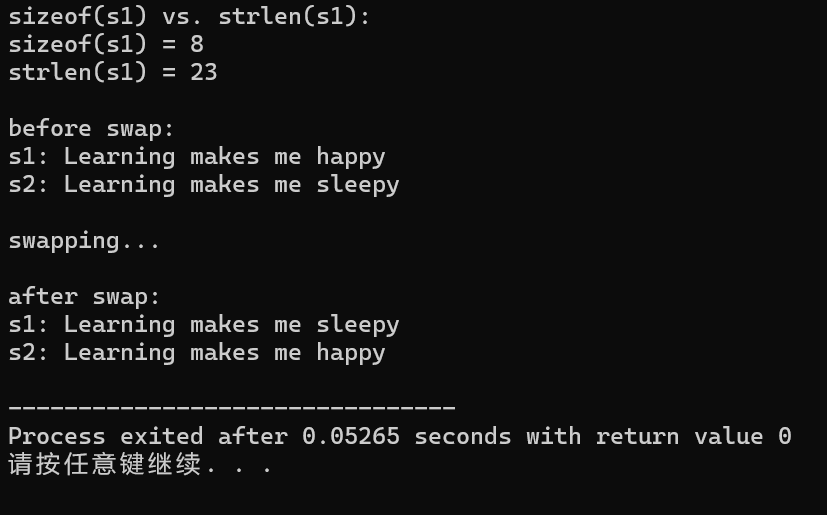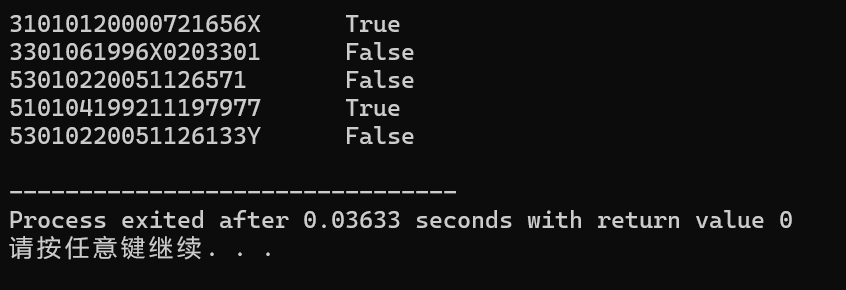实验5
实验任务1.1:
源代码:
1 #include <stdio.h> 2 #define N 5 3 4 void input(int x[], int n); 5 void output(int x[], int n); 6 void find_min_max(int x[], int n, int *pmin, int *pmax); 7 8 int main() { 9 int a[N]; 10 int min, max; 11 12 printf("录入%d个数据:\n", N); 13 input(a, N); 14 15 printf("数据是: \n"); 16 output(a, N); 17 18 printf("数据处理...\n"); 19 find_min_max(a, N, &min, &max); 20 21 printf("输出结果:\n"); 22 printf("min = %d, max = %d\n", min, max); 23 24 return 0; 25 } 26 27 void input(int x[], int n) { 28 int i; 29 30 for(i = 0; i < n; ++i) 31 scanf("%d", &x[i]); 32 } 33 34 void output(int x[], int n) { 35 int i; 36 37 for(i = 0; i < n; ++i) 38 printf("%d ", x[i]); 39 printf("\n"); 40 } 41 42 void find_min_max(int x[], int n, int *pmin, int *pmax) { 43 int i; 44 45 *pmin = *pmax = x[0]; 46 47 for(i = 0; i < n; ++i) 48 if(x[i] < *pmin) 49 *pmin = x[i]; 50 else if(x[i] > *pmax) 51 *pmax = x[i]; 52 }
运行结果:

问题1:函数 find_min_max 实现的功能:找出输入数据中的最大值和最小值
问题2:pmin指向用于存储最小值变量所对应的地址; pmax指向用于存储最大值变量所对应的地址
实验任务1.2:
源代码:
1 #include <stdio.h> 2 #define N 5 3 4 void input(int x[], int n); 5 void output(int x[], int n); 6 int *find_max(int x[], int n); 7 8 int main() { 9 int a[N]; 10 int *pmax; 11 12 printf("录入%d个数据:\n", N); 13 input(a, N); 14 15 printf("数据是: \n"); 16 output(a, N); 17 18 printf("数据处理...\n"); 19 pmax = find_max(a, N); 20 21 printf("输出结果:\n"); 22 printf("max = %d\n", *pmax); 23 24 return 0; 25 } 26 27 void input(int x[], int n) { 28 int i; 29 30 for(i = 0; i < n; ++i) 31 scanf("%d", &x[i]); 32 } 33 34 void output(int x[], int n) { 35 int i; 36 37 for(i = 0; i < n; ++i) 38 printf("%d ", x[i]); 39 printf("\n"); 40 } 41 42 int *find_max(int x[], int n) { 43 int max_index = 0; 44 int i; 45 46 for(i = 0; i < n; ++i) 47 if(x[i] > x[max_index]) 48 max_index = i; 49 50 return &x[max_index]; 51 }
运行结果:

问题1:函数 find_max 的功能:返回输入数据中最大值所对应的地址
问题2:可以
实验任务2.1:
源代码:
1 #include <stdio.h> 2 #include <string.h> 3 #define N 80 4 5 int main() { 6 char s1[N] = "Learning makes me happy"; 7 char s2[N] = "Learning makes me sleepy"; 8 char tmp[N]; 9 10 printf("sizeof(s1) vs. strlen(s1): \n"); 11 printf("sizeof(s1) = %d\n", sizeof(s1)); 12 printf("strlen(s1) = %d\n", strlen(s1)); 13 14 printf("\nbefore swap: \n"); 15 printf("s1: %s\n", s1); 16 printf("s2: %s\n", s2); 17 18 printf("\nswapping...\n"); 19 strcpy(tmp, s1); 20 strcpy(s1, s2); 21 strcpy(s2, tmp); 22 23 printf("\nafter swap: \n"); 24 printf("s1: %s\n", s1); 25 printf("s2: %s\n", s2); 26 27 return 0; 28 }
运行结果:

问题1:数组s1的大小是80个字节; sizeof(s1) 计算的是s1所占用的字节数; strlen(s1) 统计的是字符的个数
问题2:不能;数组名是一个常量指针,是地址,定义完后应该用strcpy,而不是直接等于
问题3:交换了
实验任务2.2:
源代码:
#include <stdio.h> #include <string.h> #define N 80 int main() { char *s1 = "Learning makes me happy"; char *s2 = "Learning makes me sleepy"; char *tmp; printf("sizeof(s1) vs. strlen(s1): \n"); printf("sizeof(s1) = %d\n", sizeof(s1)); printf("strlen(s1) = %d\n", strlen(s1)); printf("\nbefore swap: \n"); printf("s1: %s\n", s1); printf("s2: %s\n", s2); printf("\nswapping...\n"); tmp = s1; s1 = s2; s2 = tmp; printf("\nafter swap: \n"); printf("s1: %s\n", s1); printf("s2: %s\n", s2); return 0; }
运行结果:

问题1:指针变量s1中存放的是这个字符串的首地址; sizeof(s1) 计算的是指针变量所占用的字节数; strlen(s1) 统计的是字符串的长度
问题2:可以; task2_1.c中 是定义一个字符串数组用于存储字符串,而这里是将字符串常量的首地址赋值给s1
问题3:交换的是指针所指的地址; 字符串常量"Learning makes me happy"和字符串常量"Learning makes me sleepy"在内存中没有交换
实验任务3:
源代码:
1 int main() { 2 int x[2][4] = {{1, 9, 8, 4}, {2, 0, 4, 9}}; 3 int i, j; 4 int *ptr1; // 指针变量,存放int类型数据的地址 5 int(*ptr2)[4]; // 指针变量,指向包含4个int元素的一维数组 6 7 printf("输出1: 使用数组名、下标直接访问二维数组元素\n"); 8 for (i = 0; i < 2; ++i) { 9 for (j = 0; j < 4; ++j) 10 printf("%d ", x[i][j]); 11 printf("\n"); 12 } 13 14 printf("\n输出2: 使用指针变量ptr1(指向元素)间接访问\n"); 15 for (ptr1 = &x[0][0], i = 0; ptr1 < &x[0][0] + 8; ++ptr1, ++i) { 16 printf("%d ", *ptr1); 17 18 if ((i + 1) % 4 == 0) 19 printf("\n"); 20 } 21 22 printf("\n输出3: 使用指针变量ptr2(指向一维数组)间接访问\n"); 23 for (ptr2 = x; ptr2 < x + 2; ++ptr2) { 24 for (j = 0; j < 4; ++j) 25 printf("%d ", *(*ptr2 + j)); 26 printf("\n"); 27 } 28 29 return 0; 30 }
运行结果:

问题1:int(*ptr)[4];中,标识符ptr表示指向包含4个int元素的一维数组的指针变量
问题2:int*ptr[4];中,标识符ptr表示一个长度为4的int类型指针数组
实验任务4:
源代码:
1 #include <stdio.h> 2 #define N 80 3 4 void replace(char *str, char old_char, char new_char); // 函数声明 5 6 int main() { 7 char text[N] = "Programming is difficult or not, it is a question."; 8 9 printf("原始文本: \n"); 10 printf("%s\n", text); 11 12 replace(text, 'i', '*'); // 函数调用 注意字符形参写法,单引号不能少 13 14 printf("处理后文本: \n"); 15 printf("%s\n", text); 16 17 return 0; 18 } 19 20 // 函数定义 21 void replace(char *str, char old_char, char new_char) { 22 int i; 23 24 while(*str) { 25 if(*str == old_char) 26 *str = new_char; 27 str++; 28 } 29 }
运行结果:

问题1:函数replace的功能是将str中old_char替换成new_char,即把i换成*号
问题2:可以
实验任务5:
源代码:
1 #include <stdio.h> 2 #define N 80 3 4 char *str_trunc(char *str, char x); 5 6 int main() { 7 char str[N]; 8 char ch; 9 10 while(printf("输入字符串: "), gets(str) != NULL) { 11 printf("输入一个字符: "); 12 ch = getchar(); 13 14 printf("截断处理...\n"); 15 str_trunc(str, ch); // 函数调用 16 17 printf("截断处理后的字符串: %s\n\n", str); 18 getchar(); 19 } 20 21 return 0; 22 } 23 char *str_trunc(char *str, char x) 24 { 25 while(*str) 26 { 27 if(*str != x) 28 { 29 str++; 30 } 31 else 32 { 33 *str='\0'; 34 break; 35 } 36 } 37 return str; 38 }
运行结果:

问题1:除了第一组,其余直接跳过了输入一个字符进行截断处理的步骤
问题2:将换行符读取走,避免对之后程序产生影响
实验任务6:
源代码:
1 #include <stdio.h> 2 #include <string.h> 3 #define N 5 4 5 int check_id(char *str); // 函数声明 6 7 int main() 8 { 9 char *pid[N] = {"31010120000721656X", 10 "3301061996X0203301", 11 "53010220051126571", 12 "510104199211197977", 13 "53010220051126133Y"}; 14 int i; 15 16 for (i = 0; i < N; ++i) 17 if (check_id(pid[i])) // 函数调用 18 printf("%s\tTrue\n", pid[i]); 19 else 20 printf("%s\tFalse\n", pid[i]); 21 22 return 0; 23 } 24 int check_id(char *str) 25 { 26 if (strlen(str) != 18) 27 return 0; 28 29 for (int i = 0; i < 17; i++) 30 if (str[i] > '9'||str[i]<'0') 31 return 0; 32 33 if ((str[17] <= '9' && str[17] >= '0') || str[17] == 'X') 34 return 1; 35 else 36 return 0; 37 }
运行结果:

实验任务7:
源代码:
1 #include <stdio.h> 2 #define N 80 3 void encoder(char *str, int n); // 函数声明 4 void decoder(char *str, int n); // 函数声明 5 6 int main() { 7 char words[N]; 8 int n; 9 10 printf("输入英文文本: "); 11 gets(words); 12 13 printf("输入n: "); 14 scanf("%d", &n); 15 16 printf("编码后的英文文本: "); 17 encoder(words, n); // 函数调用 18 printf("%s\n", words); 19 20 printf("对编码后的英文文本解码: "); 21 decoder(words, n); // 函数调用 22 printf("%s\n", words); 23 24 return 0; 25 } 26 void encoder(char *str, int n) { 27 while (*str) 28 { 29 if (*str >= 'a' && *str <= 'z') 30 { 31 *str = (*str - 'a' + n ) % 26 + 'a'; 32 } 33 if (*str >= 'A' && *str <= 'Z') 34 { 35 *str = (*str - 'A' + n ) % 26 + 'A'; 36 } 37 str++; 38 } 39 } 40 void decoder(char *str, int n) { 41 while (*str) 42 { 43 if (*str >= 'a' && *str <= 'z') 44 { 45 *str = (*str - 'a' - n + 26) % 26 + 'a'; 46 } 47 if (*str >= 'A' && *str <= 'Z') 48 { 49 *str = (*str - 'A' - n + 26) % 26 + 'A'; 50 } 51 str++; 52 } 53 }
运行结果:



实验任务8:
源代码:
1 #include <stdio.h> 2 #include<strings.h> 3 int main(int argc, char *argv[]) { 4 int i; 5 for(i=1;i<argc;i++) 6 { 7 for(int j=1;j<argc-i;j++) 8 { 9 char *temp; 10 if(strcmp(argv[j],argv[j+1])>0) 11 { 12 temp=argv[j]; 13 argv[j]=argv[j+1]; 14 argv[j+1]=temp; 15 } 16 } 17 } 18 for(i = 1; i < argc; ++i) 19 printf("hello, %s\n", argv[i]); 20 21 return 0; 22 }
运行结果:


实验总结:
对指针有更深的理解,能利用指针编写基本的程序




